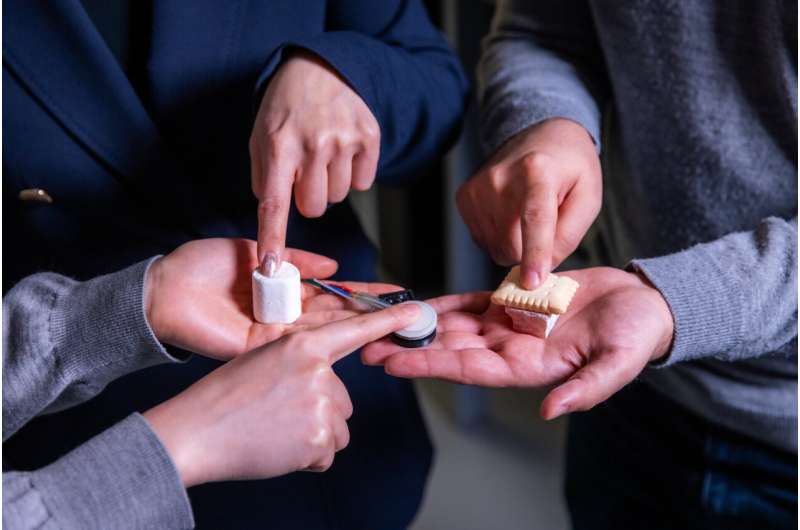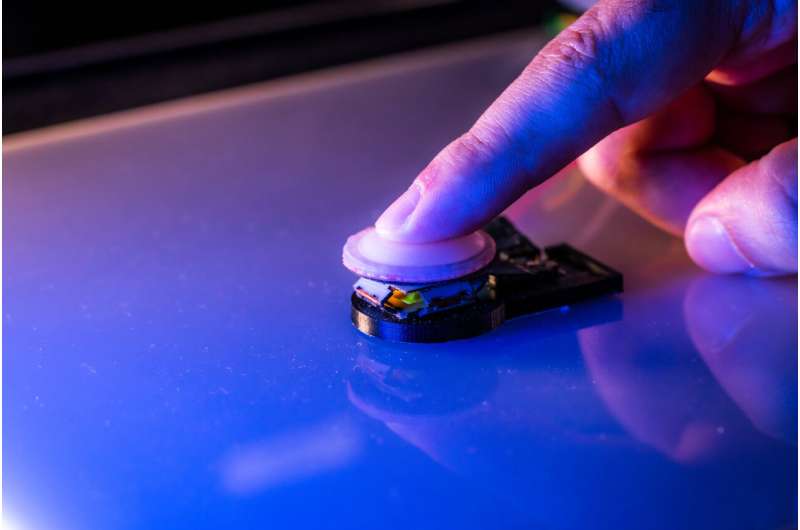This article has been reviewed according to Science X's editorial process and policies. Editors have highlighted the following attributes while ensuring the content's credibility:
fact-checked
peer-reviewed publication
trusted source
proofread

The perception of softness can be taken for granted, but it plays a crucial role in many actions and interactions—from judging the ripeness of an avocado to conducting a medical exam, or holding the hand of a loved one. But understanding and reproducing softness perception is challenging because it involves so many sensory and cognitive processes.
Robotics researchers have tried to address this challenge with haptic devices, but previous attempts have not distinguished between two primary elements of softness perception: cutaneous cues (sensory feedback from the skin of the fingertip), and kinesthetic cues (feedback about the amount of force on the finger joint).
"If you press on a marshmallow with your fingertip, it's easy to tell that it's soft. But if you place a hard biscuit on top of that marshmallow and press again, you can still tell that the soft marshmallow is underneath, even though your fingertip is touching a hard surface," explains Mustafa Mete, a Ph.D. student in the Reconfigurable Robotics Lab in the School of Engineering. "We wanted to see if we could create a robotic platform that can do the same."
With SORI (Softness Rendering Interface), the RRL, led by Jamie Paik, has achieved just that. By decoupling cutaneous and kinesthetic cues, SORI faithfully recreates the softness of a range of real materials, filling a gap in the robotics field and enabling many applications where softness sensation is critical—from deep-sea exploration to robot-assisted surgery.
The research appears in the Proceedings of the National Academy of Sciences.
We all feel softness differently
Mete explains that neuroscientific and psychological studies show that cutaneous cues are largely based on how much skin is in contact with a surface, which is often related in part to the deformation of the object. In other words, a surface that envelopes a greater area of your fingertip will be perceived as softer. But because human fingertips vary widely in size and firmness, one finger may make greater contact with a given surface than another.
"We realized that the softness I feel may not be the same as the softness you feel, because of our different finger shapes. So, for our study, we first had to develop parameters for the geometries of a fingertip and its contact surface in order to estimate the softness cues for that fingertip," Mete explains. Then, the researchers extracted the softness parameters from a range of different materials and mapped both sets of parameters onto the SORI device.
Building on the RRL's trademark origami robot research, which has fueled spinoffs for reconfigurable environments and a haptic joystick, SORI is equipped with motor-driven origami joints that can be modulated to become stiffer or more supple. Perched atop the joints is a dimpled silicone membrane. A flow of air inflates the membrane to varying degrees, to envelop a fingertip placed at its center.

With this novel decoupling of kinesthetic and cutaneous functionality, SORI succeeded in recreating the softness of a range of materials—including beef, salmon, and marshmallow—over the course of several experiments with two human volunteers. It also mimicked materials with both soft and firm attributes (such as a biscuit on top of a marshmallow, or a leather-bound book). In one virtual experiment, SORI even reproduced the sensation of a beating heart, to demonstrate its efficacy at rendering soft materials in motion.
Medicine is therefore a primary area of potential application for this technology; for example, to train medical students to detect cancerous tumors, or to provide crucial sensory feedback to surgeons using robots to perform operations.
Other applications include robot-assisted exploration of space or the deep ocean, where the device could enable scientists to feel the softness of a discovered object from a remote location. SORI is also a potential answer to one of the biggest challenges in robot-assisted agriculture: harvesting tender fruits and vegetables without crushing them.
"This is not intended to act as a softness sensor for robots, but to transfer the feeling of 'touch' digitally, just like sending photos or music," Mete says.
More information: Mustafa Mete et al, SORI: A softness-rendering interface to unravel the nature of softness perception, Proceedings of the National Academy of Sciences (2024). DOI: 10.1073/pnas.2314901121
Citation: Robotic interface masters a soft touch (2024, March 11) retrieved 11 March 2024 from https://ift.tt/mSKURFy
This document is subject to copyright. Apart from any fair dealing for the purpose of private study or research, no part may be reproduced without the written permission. The content is provided for information purposes only.
Explore further
"interface" - Google News
March 12, 2024 at 02:49AM
https://ift.tt/ZasItFn
Robotic interface masters a soft touch - Tech Xplore
"interface" - Google News
https://ift.tt/5CpEPmD
https://ift.tt/r9Koi3k
Bagikan Berita Ini














0 Response to "Robotic interface masters a soft touch - Tech Xplore"
Post a Comment